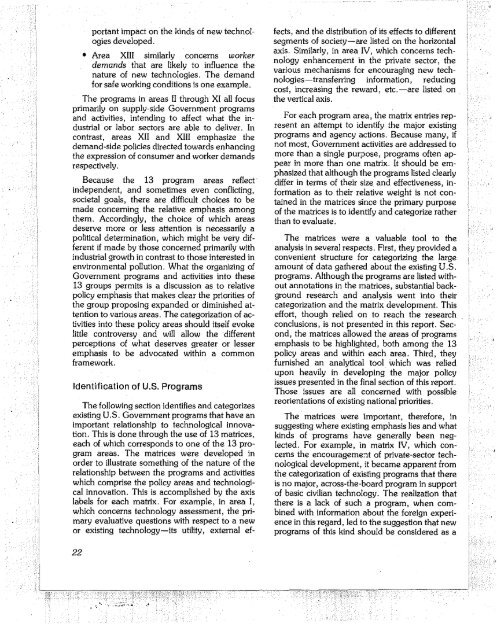Office of Technology Assessment - Bayhdolecentral
Office of Technology Assessment - Bayhdolecentral
Office of Technology Assessment - Bayhdolecentral
Create successful ePaper yourself
Turn your PDF publications into a flip-book with our unique Google optimized e-Paper software.
portant impact on the kinds <strong>of</strong> new technologies<br />
developed.<br />
• Area XIII similarly concerns worker<br />
demands that are likely to influence the<br />
nature <strong>of</strong> new technologies. The demand<br />
for safe working conditions is one example.<br />
The programs in areas II through XI all focus<br />
primarily on supply-side Government programs<br />
and activities, intending to affect what the industrial<br />
or labor sectors are able to deliver. In<br />
contrast, areas XII and XIII emphasize the<br />
demand-side policies directed towards enhancing<br />
the expression <strong>of</strong> consumer and worker demands<br />
respectively.<br />
Because the 13 program areas reflect<br />
independent, and sometimes even conflicting,<br />
societal goals, there are difficult choices to be<br />
made concerning the relative emphasis among<br />
them. Accordingly, the choice <strong>of</strong> which areas<br />
deserve more or less attention is necessarily a<br />
political determination, which might be very different<br />
if made by those concerned primarily with<br />
industrial growth in contrast to those interested in<br />
environmental pollution. What the organizing <strong>of</strong><br />
Government programs and activities into these<br />
13 groups permits is a discussion as to relative<br />
policy emphasis that makes clear the priorities <strong>of</strong><br />
the group proposing expanded or diminished attention<br />
to various areas. The categorization <strong>of</strong> activities<br />
into these policy areas should itself evoke<br />
little controversy and will allow the 'different<br />
perceptions <strong>of</strong> what deserves greater or lesser<br />
emphasis to be advocated within a common<br />
framework.<br />
Identification <strong>of</strong> U.S. Programs<br />
The following section identifies and categorizes<br />
existing U.S. Government programs that have an<br />
important relationship to technological innovation.<br />
This is done through the use <strong>of</strong> 13 matrices,<br />
each <strong>of</strong> which corresponds to one <strong>of</strong> the 13 program<br />
areas. The matrices were developed in<br />
order to illustrate something <strong>of</strong> the nature <strong>of</strong> the<br />
relationship between the programs and activities<br />
which comprise the policy areas and technological<br />
innovation. This is accomplished by the axis<br />
labels for each matrix. For example, in area I,<br />
which concerns technology assessment, the primary<br />
evaluative questions with respect to a new<br />
or existing technology-its utility, external ef-<br />
22<br />
fects, and the distribution <strong>of</strong> its effects to different<br />
segments <strong>of</strong> society-are listed on the horizontal<br />
axis. Similarly, in area IV, which concerns technolOgy<br />
enhancement in the private sector, the<br />
various mechanisms for encouraging new technologies-transferring<br />
information, reducing<br />
cost, increasing the reward, etc.-are listed on<br />
the vertical axis.<br />
For each program area, the matrix entries represent<br />
an attempt to identify the major existing<br />
programs and agency actions. Because many, if<br />
not most, Government activities are addressed to<br />
more than a single purpose, programs <strong>of</strong>ten appear<br />
in more than one matrix. It should be emphasized<br />
that although the programs listed clearly<br />
differ in terms <strong>of</strong> their size and effectiveness, information<br />
as to their relative weight is not contained<br />
in the matrices since the primary purpose<br />
<strong>of</strong> the matrices is to identify and categorize rather<br />
than to evaluate.<br />
The matrices were a valuable tool to the<br />
analysis in several respects. First, they provided a<br />
convenient structure for categorizing the large<br />
amount <strong>of</strong> data gathered about the existing U.S.<br />
programs. Although the programs are listed without<br />
annotations in the matrices, substantial background<br />
research and analysis went into their<br />
categorization and the matrix development. This<br />
effort, though relied on to reach the research<br />
conclusions, is not presented in this report. Second,<br />
the matrices allowed the areas <strong>of</strong> programs<br />
emphasis to be highlighted, both among the 13<br />
policy areas and within each area. Third, they<br />
furnished an analytical tool which was relied<br />
upon heavily in developing the major policy<br />
issues presented in the final section <strong>of</strong> this report.<br />
Those issues are all concerned with possible<br />
reorientations <strong>of</strong> existing national priorities.<br />
The matrices were important, therefore, in<br />
suggesting where existing emphasis lies and what<br />
kinds <strong>of</strong> programs have generally been neglected.<br />
For example, in matrix IV, which concerns<br />
the encouragement <strong>of</strong> private-sector technological<br />
development, it became apparent from<br />
the categorization <strong>of</strong> existing programs that there<br />
is no major, across-the-board program in support<br />
<strong>of</strong> basic civilian technology. The realization that<br />
there is a lack <strong>of</strong> such a program, when combined<br />
with information about the foreign experience<br />
in this regard, led to the suggestion that new<br />
programs <strong>of</strong> this kind should be considered as a
















